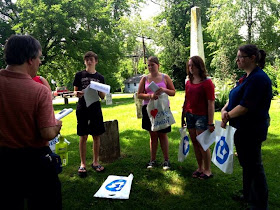Yesterday Miss Meg, MPL teen/adult programming coordinator, held a hands-on genealogy program for teens at Old Cemetery (i.e., the old Methodist Episcopal [M.E.] Church Cemetery) on West Washington Street near downtown Mooresville, Indiana, about which we've previously blogged. Participants rubbed tombstones to preserve a record of persons buried there. Miss Meg took some photos of the event. Click the images to enlarge.
Hannibal Bray's grave
(Not the movie character)
(son of John S. & Margaret Bray)
(died 8/11/1854; age 10 mo., 4 days)
Grave of Washington L. Conduitt (6/1/1825-8/27/1861)
(born in Trimble County, Kentucky)
Samuel & Eliza Moore's son-in-law
(Samuel Moore founded the Town of Mooresville, Indiana)
(Samuel Moore founded the Town of Mooresville, Indiana)
Cemeteries are silent repositories of family history
William A. Rooker's grave marker
(died 8/15/1849; age 30 yrs., 6 mo., 9 days)
(One of many that have been damaged)
Grave of Mary M. Conduitt
(1/15/1831-10/13/1853)
(daughter of Samuel & Eliza Moore)
(wife of Washington Conduitt)
(1/15/1831-10/13/1853)
(daughter of Samuel & Eliza Moore)
(wife of Washington Conduitt)
Tombstone rubbing is one way to preserve the information chiseled on grave markers, but it can be destructive to the stones if done improperly or haphazardly. An alternative is digital photography. Editing a cemetery marker using Photoshop (or some other graphics software) can bring out details difficult to discern with the naked eye, particularly if the image is inverted (i.e., a negative image) or sharpened with other filtering options.
Photo Inversion (Negative)
brings out clearer details from tombstone
Everyone enjoyed investigating and learning to preserve burial information for one's genealogical researches. Cemeteries tell many stories, if one quietly and respectfully listens.













No comments:
Post a Comment
Note: Only a member of this blog may post a comment.